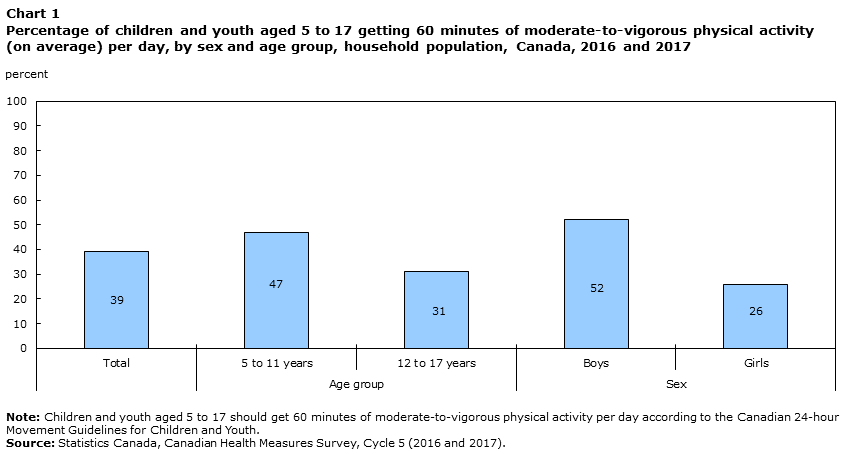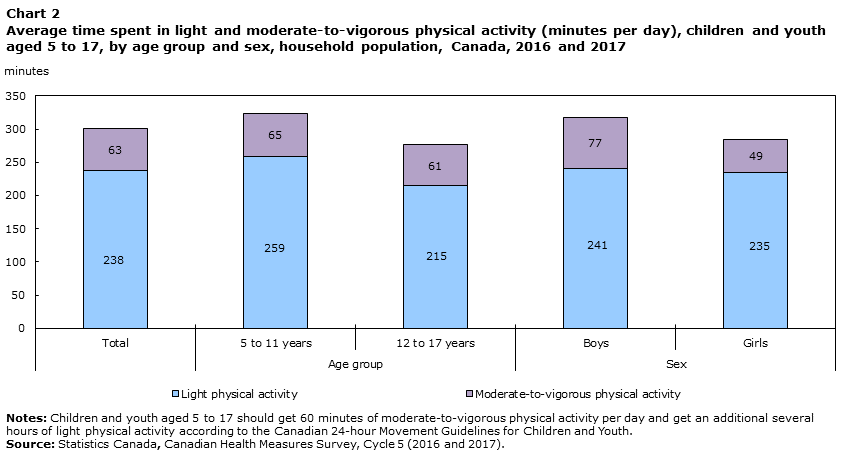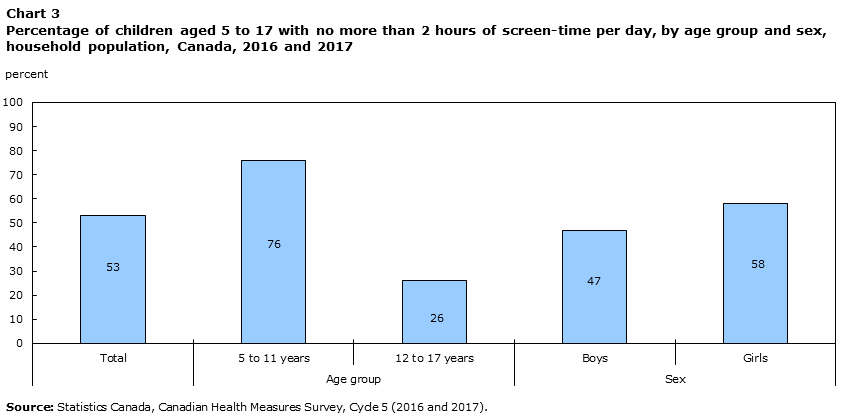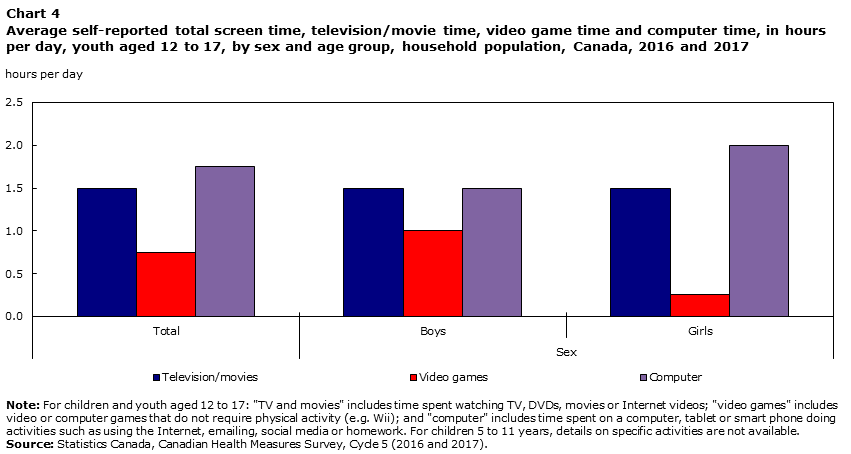Health Fact Sheets
Physical activity and screen time among Canadian children and youth, 2016 and 2017
Archived Content
Information identified as archived is provided for reference, research or recordkeeping purposes. It is not subject to the Government of Canada Web Standards and has not been altered or updated since it was archived. Please "contact us" to request a format other than those available.
Regular physical activity among children and youth is related to improvements in cholesterol levels, blood pressure, body composition, bone density, physical fitness, academic achievement, and aspects of mental health including self-esteem.Note 1 Conversely, recreational sedentary behaviour, such as time spent watching TV or playing video games, is linked to obesity, metabolic syndrome, hypertension and poorer scores in psychosocial health indicators such as body-satisfaction.Note 2
In Canada, recommendations on physical activity, sedentary behaviour and sleep in children and youth are outlined in the Canadian 24-Hour Movement Guidelines for Children and Youth.Note 3 The guidelines recommend that children and youth aged 5 to 17:
- get at least 60 minutes of moderate-to-vigorous physical activity (MVPA) per day, on average. This can be accomplished through a range of activities such as bicycling, rollerblading, soccer, football, etc.;
- get an additional several hours of light physical activity (LPA) through structured and unstructured activities. This can be accomplished through activities such as walking, stretching, playing with animals, etc.;
- limit their recreational screen time to no more than 2 hours per day, on average; and
- get plenty of uninterrupted sleep (9 to 11 hours for 5 to 13 year olds and 8 to 10 hours for 14 to 17 year olds).
Nearly 40% of children and youth aged 5 to 17 met the physical activity target
Approximately 2 out of 5 children and youth aged 5 to 17 met the recommended physical activity target of 60 minutes of MVPA per day, on average (Chart 1). Boys (52%) were two times as likely as girls (26%) and children aged 5 to 11, (47%) were 1.5 times as likely as youth aged 12-17, (31%) to meet the recommendation.

Data table for Chart 1
| Percent | ||
|---|---|---|
| Total | 39 | |
| Age group | 5 to 11 years | 47 |
| 12 to 17 years | 31 | |
| Sex | Boys | 52 |
| Girls | 26 | |
|
Note: Children and youth aged 5 to 17 should get 60 minutes of moderate-to-vigorous physical activity per day according to the Canadian 24-hour Movement Guidelines for Children and Youth.
Source: Statistics Canada, Canadian Health Measures Survey, Cycle 5 (2016 and 2017). |
||
On average, children and youth aged 5 to 17 spent 63 minutes per day in MVPA (Chart 2). Average daily MVPA was slightly higher for children (65 minutes) compared to youth (61 minutes) and significantly higher for boys (77 minutes) compared to girls (49 minutes).

Data table for Chart 2
| Light physical activity | Moderate-to-vigorous physical activity | ||
|---|---|---|---|
| minutes/day | |||
| Total | 238 | 63 | |
| Age group | 5 to 11 years | 259 | 65 |
| 12 to 17 years | 215 | 61 | |
| Sex | Boys | 241 | 77 |
| Girls | 235 | 49 | |
|
Notes: Children and youth aged 5 to 17 should get 60 minutes of moderate-to-vigorous physical activity per day and get an additional several hours of light physical activity according to the Canadian 24-hour Movement Guidelines for Children and Youth.
Source: Statistics Canada, Canadian Health Measures Survey, Cycle 5 (2016 and 2017). |
|||
On average, children and youth aged 5 to 17 spent an additional 238 minutes (3 hours and 58 minutes) in light physical activity (LPA) (Chart 2). Similar to MVPA, LPA was slightly higher for children (4 hours and 19 minutes) compared to youth (3 hours and 35 minutes), however there was no difference between boys (4 hours and 1 minute) and girls (3 hours and 55 minutes).
Just over half of children and youth aged 5 to 17 had no more than two hours of screen time per day
Just over half (53%) of children and youth aged 5 to 17 met the recommendation to spend no more than 2 hours of screen-time per day, on average (Chart 3). Children (76%) were more than two times as likely as youth (26%) to meet the recommendation. However, girls (58%) were more likely than boys (47%) to meet the recommendation.

Data table for Chart 3
| Percent | ||
|---|---|---|
| Total | 53 | |
| Age group | 5 to 11 years | 76 |
| 12 to 17 years | 26 | |
| Sex | Boys | 47 |
| Girls | 58 | |
| Source: Statistics Canada, Canadian Health Measures Survey, Cycle 5 (2016 and 2017). | ||
On average, children and youth aged 5 to 17 had 3 hours of screen time per day (data not shown). Screen time was slightly lower for children (2.5 hours) compared to youth (4 hours). There were no differences between boys (3 hours) and girls (3 hours).
Youth aged 12 to 17 were asked about specific types of screen time activities, such as:
- time spent watching TV, DVDs, movies or Internet videos;
- time spent playing video games (including on the computer)Note 4;
- time spent on a computer, tablet or smart phone doing activities such as browsing the Internet, emailing, on social media or doing homework.
Among youth, on average per day, about 1.5 hours was spent watching TV or movies, 1.75 hours was spent on the computer and 0.75 hours was spent playing video games (Chart 4). Boys (1 hour) spent slightly more time playing video games than girls (0.25 hours) while girls (2 hours) spent slightly more time on the computer than boys (1.5 hours).

Data table for Chart 4
| Television/movies | Video games | Computer | ||
|---|---|---|---|---|
| hours per day | ||||
| Total | 1.50 | 0.75 | 1.75 | |
| Sex | Boys | 1.50 | 1.00 | 1.50 |
| Girls | 1.50 | 0.25 | 2.00 | |
|
Note: For children and youth aged 12 to 17: "TV and movies" includes time spent watching TV, DVDs, movies or Internet videos; "video games" includes video or computer games that do not require physical activity (e.g. Wii); and "computer" includes time spent on a computer, tablet or smart phone doing activities such as using the Internet, emailing, social media or homework. For children 5 to 11 years, details on specific activities are not available. Source: Statistics Canada, Canadian Health Measures Survey, Cycle 5 (2016 and 2017). |
||||
Sleep among children and youth
The Canadian 24-Hour Movement Guidelines for Children and Youth also provide recommendations on sleep as longer sleep duration is linked to reduced body fat, improved academic achievement and better quality of life. Moreover, it is associated with improved regulation of stress, anxiety and depressive symptoms.Note 5 The guidelines recommend that children aged 5 to 13 get 9 to 11 hours and youth aged 14 to 17 get 8 to 10 hours of uninterrupted sleep.Note 3
Estimates for sleep duration are not available from the 2016 and 2017 CHMS, but results from the 2009 to 2011 CHMS combined with the 2012 and 2013 CHMS showed that three-quarters (75%) of children and youth met the recommendation.Note 6 Children aged 5 to 11 were more likely to get enough sleep (83%) compared to youth aged 12 to 17 (68%). There were no differences between boys (77%) and girls (73%).
When combining MVPA, screen-time and sleep, about 18% of children and youth met all three recommendations.Note 6 Children aged 5 to 11 (29%) were more than 4 times more likely than youth aged 12 to 17 (6%) to meet all three recommendations. Boys (23%) were nearly two times more likely than girls (12%) to meet all three recommendations. However, about one in ten (11%) children and youth did not meet any of the recommendations.Note 6
Start of text boxAbout Physical Activity
The activity monitor was worn on an elasticized belt over the right hip. An activity monitor measures the acceleration of movement, recording it as a count per minute (cpm) value. The cpm values provide information on the amount of time spent being sedentary, in light activity, and in moderate-to-vigorous physical activity. The activity monitor also captures step in counts per day, which is another measure that can be used to assess physical activity levels in children and youth.Note 7
- Date modified:

